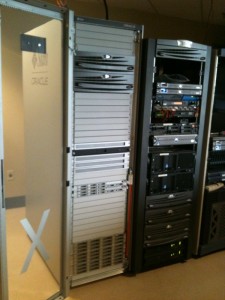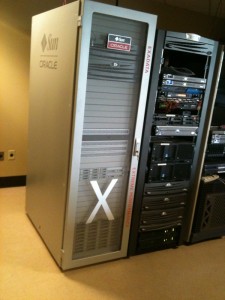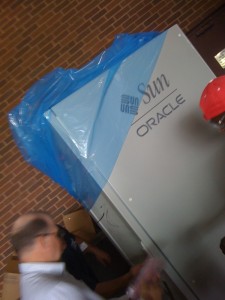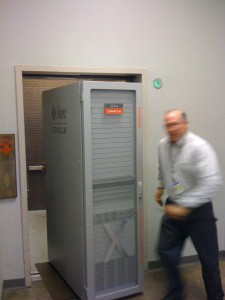One of the things I didn’t really talk about in my first post on Exadata was the flash cache component of the storage servers. They are a key component of the “OLTP” claims that Oracle is making for the platform. So let’s talk about the hardware first. The storage servers have 4 of the Sun Flash Accelerator F20 PCIe cards. These cards hold 96G each for a total of 384G on each storage server. That’s well over a terabyte on the smallest quarter rack configuration. Here’s what they look like:
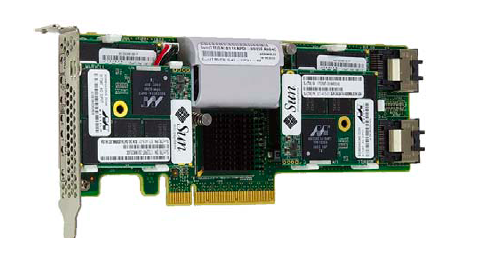
Note that they are only installed in the storage servers and not in the database servers. The cards are usually configured exclusively as Flash Cache, but can optionally have a portion defined as a “ram disk”.
Oracle has a White Paper here:
Exadata Smart Flash Cache and the Sun Oracle Database Machine
This white paper was published in late 2009 and it is specific to V2. It has some good information and is well worth reading. One of the comments I found interesting was the discussion of carving a piece of the Flash Cache out as a “disk”. Here’s the quote:
These high-performance logical flash disks can be used to store frequently accessed data. To use them requires advance planning to ensure adequate space is reserved for the tablespaces stored on them. In addition, backup of the data on the flash disks must be done in case media recovery is required, just as it would be done for data stored on conventional disks. This option is primarily useful for highly write intensive workloads where the disk write rate is higher than the disks can keep up with.
Do not confuse the use of these cards in the storage server with the new 11gR2 feature “Database Flash Cache”. That feature allows an extended SGA (level 2) cache to be created on a database server (if you are using Solaris or Oracle Enterprise Linux) and has nothing to do with the Exadata Smart Flash Cache which resides on the Exadata storage servers. Think of the Database Flash Cache as an extended SGA and the Exadata Smart Flash Cache as large “smart” disk cache. I say smart because it implements some of the same type of Oracle cache management features as the SGA.
Kevin Closson has a couple of good posts outlining the differences between Database Flash Cache and Exadata Smart Flash Cache here:
Pardon Me, Where Is That Flash Cache? Part I.
Pardon Me, Where Is That Flash Cache? Part II.
Note also that Exadata Smart Flash Cache does not affect writes (i.e. it is not a write cache).
So how do we see what’s going on with the Exadata Flash Cache? Well there are a couple of ways.
- We can use the cellcli utility on the storage servers themselves.
- We can look in v$sesstat (one of the best ways to do that is with Tanel Poder’s snapper script by the way).
Here’s a little output from the system showing method 1 (cellcli):
[root@dm01cel01 ~]# cellcli
CellCLI: Release 11.2.1.2.3 - Production on Fri Apr 30 16:09:29 CDT 2010
Copyright (c) 2007, 2009, Oracle. All rights reserved.
Cell Efficiency Ratio: 38M
CellCLI> LIST METRICCURRENT WHERE objectType = 'FLASHCACHE'
FC_BYKEEP_OVERWR FLASHCACHE 0.0 MB
FC_BYKEEP_OVERWR_SEC FLASHCACHE 0.0 MB/sec
FC_BYKEEP_USED FLASHCACHE 300.6 MB
FC_BY_USED FLASHCACHE 135,533.7 MB
FC_IO_BYKEEP_R FLASHCACHE 10,399.4 MB
FC_IO_BYKEEP_R_SEC FLASHCACHE 0.0 MB/sec
FC_IO_BYKEEP_W FLASHCACHE 6,378.3 MB
FC_IO_BYKEEP_W_SEC FLASHCACHE 0.0 MB/sec
FC_IO_BY_R FLASHCACHE 480,628.3 MB
FC_IO_BY_R_MISS FLASHCACHE 55,142.4 MB
FC_IO_BY_R_MISS_SEC FLASHCACHE 0.0 MB/sec
FC_IO_BY_R_SEC FLASHCACHE 0.1 MB/sec
FC_IO_BY_R_SKIP FLASHCACHE 1,448,220.2 MB
FC_IO_BY_R_SKIP_SEC FLASHCACHE 12.8 MB/sec
FC_IO_BY_W FLASHCACHE 178,761.9 MB
FC_IO_BY_W_SEC FLASHCACHE 0.1 MB/sec
FC_IO_ERRS FLASHCACHE 0
FC_IO_RQKEEP_R FLASHCACHE 1051647 IO requests
FC_IO_RQKEEP_R_MISS FLASHCACHE 291829 IO requests
FC_IO_RQKEEP_R_MISS_SEC FLASHCACHE 0.0 IO/sec
FC_IO_RQKEEP_R_SEC FLASHCACHE 0.0 IO/sec
FC_IO_RQKEEP_R_SKIP FLASHCACHE 0 IO requests
FC_IO_RQKEEP_R_SKIP_SEC FLASHCACHE 0.0 IO/sec
FC_IO_RQKEEP_W FLASHCACHE 176405 IO requests
FC_IO_RQKEEP_W_SEC FLASHCACHE 0.0 IO/sec
FC_IO_RQ_R FLASHCACHE 21095663 IO requests
FC_IO_RQ_R_MISS FLASHCACHE 1574404 IO requests
FC_IO_RQ_R_MISS_SEC FLASHCACHE 0.6 IO/sec
FC_IO_RQ_R_SEC FLASHCACHE 1.6 IO/sec
FC_IO_RQ_R_SKIP FLASHCACHE 4879720 IO requests
FC_IO_RQ_R_SKIP_SEC FLASHCACHE 26.8 IO/sec
FC_IO_RQ_W FLASHCACHE 5665344 IO requests
FC_IO_RQ_W_SEC FLASHCACHE 2.9 IO/sec
Continue reading ‘Oracle Exadata V2 – Flash Cache’ »

